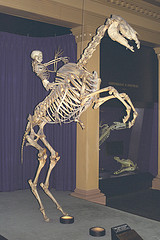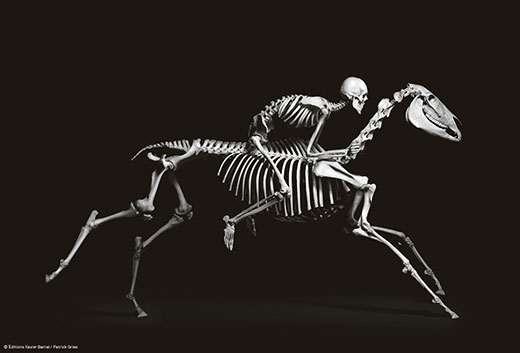If you “ride with your bones,” your muscles won’t have to work so hard.
Riding with your bones requires an understanding of skeletal anatomy–where the bones are and how they articulate.
– Sally Swift
Our bones ride our horse’s bones.
The skeleton consists of both fused and individual bones. Bone is a dynamic living part of the body. New bone is constantly produced and old bone removed. The skeleton supports the body structure and provides protection to major organs. Ligaments, tendons, muscles, and cartilage support the skeleton.
Muscles work with bones as levers to move our body. A ligament is a dense fibrous tissue that connects bone to bone stabilizing the joints. Tendons are fibrous bands that connect muscle to bone. Cartilage is a gel-like substance that provides cushioning between bones.
A joint (or articulation) is a point of contact between bones or between cartilage and bones. There are several different types of joints. Fibrous joints are immovable, for example between the bones of the skull. Cartilaginous joints, such as the spinal vertebrae, contain cartilage to cushion the bones and allow some movement. Synovial joints are the most common and most movable.
Examples of Hinge, Pivot, Ball and Socket synovial joints
- Hinge joints allow movement in only one direction similar to opening and closing of a hinged door. The elbow and knee are hinge joints.
- Pivot joints allow for rotation around an axis, such as your head on the top of your spine.
- Ball and socket joints are the most mobile type of joint in the human body, such as the shoulder and hip joints. They allow for forward motion, backward motion and circular rotation.
Examples of Condyloid, Gliding, Saddle synovial joints
- The joint at the base of the index finger is a condyloid (ellipsoidal) joint. It can move side to side and front to back, but cannot rotate.
- Gliding joints have two bone plates that glide against one another, such as some bones in the wrist.
- The thumb is a saddle joint allowing for movement back and forth and up and down in two directions.
Try moving and bending your various synovial joints and note the different methods of movement allowed in your body.


